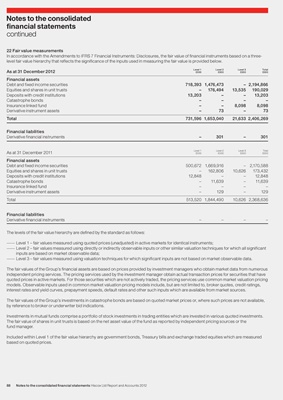
Notes to the consolidated
financial statements
continued
22 Fair value measurements
In accordance with the Amendments to IFRS 7 Financial Instruments: Disclosures, the fair value of financial instruments based on a three-
level fair value hierarchy that reflects the significance of the inputs used in measuring the fair value is provided below.
Level 1 Level 2 Level 3 Total
As at 31 December 2012 £000 £000 £000 £000
Financial assets
Debt and fixed income securities 718,393 1,476,473 – 2,194,866
Equities and shares in unit trusts – 176,494 13,535 190,029
Deposits with credit institutions 13,203 – – 13,203
Catastrophe bonds – – – –
Insurance linked fund – – 8,098 8,098
Derivative instrument assets – 73 – 73
Total 731,596 1,653,040 21,633 2,406,269
Financial liabilities
Derivative financial instruments – 301 – 301
Level 1 Level 2 Level 3 Total
As at 31 December 2011 £000 £000 £000 £000
Financial assets
Debt and fixed income securities 500,672 1,669,916 – 2,170,588
Equities and shares in unit trusts – 162,806 10,626 173,432
Deposits with credit institutions 12,848 – – 12,848
Catastrophe bonds – 11,639 – 11,639
Insurance linked fund – – – –
Derivative instrument assets – 129 – 129
Total 513,520 1,844,490 10,626 2,368,636
Financial liabilities
Derivative financial instruments – – – –
The levels of the fair value hierarchy are defined by the standard as follows:
Level 1 – fair values measured using quoted prices (unadjusted) in active markets for identical instruments;
Level 2 – fair values measured using directly or indirectly observable inputs or other similar valuation techniques for which all significant
inputs are based on market observable data;
Level 3 – fair values measured using valuation techniques for which significant inputs are not based on market observable data.
The fair values of the Group’s financial assets are based on prices provided by investment managers who obtain market data from numerous
independent pricing services. The pricing services used by the investment manager obtain actual transaction prices for securities that have
quoted prices in active markets. For those securities which are not actively traded, the pricing services use common market valuation pricing
models. Observable inputs used in common market valuation pricing models include, but are not limited to, broker quotes, credit ratings,
interest rates and yield curves, prepayment speeds, default rates and other such inputs which are available from market sources.
The fair values of the Group’s investments in catastrophe bonds are based on quoted market prices or, where such prices are not available,
by reference to broker or underwriter bid indications.
Investments in mutual funds comprise a portfolio of stock investments in trading entities which are invested in various quoted investments.
The fair value of shares in unit trusts is based on the net asset value of the fund as reported by independent pricing sources or the
fund manager.
Included within Level 1 of the fair value hierarchy are government bonds, Treasury bills and exchange traded equities which are measured
based on quoted prices.
88 Notes to the consolidated financial statements Hiscox Ltd Report and Accounts 2012